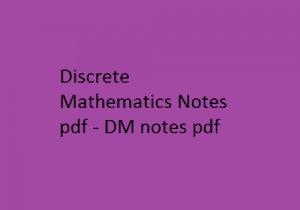Free Download Pdf Discrete Mathematics
Here you can download the free lecture Notes of Discrete Mathematics Pdf Notes – DM notes pdf materials with multiple file links to download. The Discrete Mathematics Notes pdf – DM notes pdf book starts with the topics covering Logic and proof, strong induction,pigeon hole principle, isolated vertex, directed graph, Alebric structers, lattices and boolean algebra, Etc.

Discrete Mathematics pdf notes – DM notes pdf file
file to download are listed below please check it –
Complete Notes
Link:Complete Notes
Unit 1
Link:Unit 1 Notes
Unit 2
Link:Unit 2 Notes
Unit 3
Link:Unit 3 Notes
Unit 4
Link:Unit 4 Notes
Unit 5
Link:Unit 5 Notes
Note :- These notes are according to the R09 Syllabus book of JNTU.In R13 and R15,8-units of R09 syllabus are combined into 5-units in R13 and R15 syllabus. If you have any doubts please refer to the JNTU Syllabus Book.
Unit-1:
Logic and proof, propositions on statement, connectives, basic connectives, truth table for basic connectives,And,Disjunction,conditional state,bi conditional state,tautology,contradiction,fallacy,contigency,logical equialances,idempotent law,associtative law,commutative law,demorgans law,distributive law,complements law,dominance law,identity law.A praposition of on statement is a declarative sentence which either true (or) false not both, connective is an operation
Unit-2:
Combinatorics, strong induction,pigeon hole principle, permutation and combination, recurrence relations, linear non homogeneous recurrence relation with constant, the principle of inclusion and exclusion.
Discrete Mathematics Notes pdf – DM notes pdf
Unit-3:
Graphs, parllel edges, adjacent edges and vertices,simple graph,isolated vertex,directed graph,undirected graph,mixed graph,multigraph,pseduo graph,degree,in degree and outdegree,therom,regular graph,complete graph,complete bipartite,subgraph,adjecent matrix of a simple graph,incidence matrix,path matrix,graph isomorphism,pths,rechabality and connected path,length of the path,cycle,connected graph,components of a graph,konisberg bridge problem,Euler parh,euler circuit,hamiltonian path,hamiltonian cycle.
Unit-4:
Alebric structers,properties,closure,commutativity,associativity,identity,inverse,distributive law,inverse element,notation,semi group,monoid,cycle monoid,morphisms of semigrouphs,morpism of monoids,groups,abelian group,order of group,composition table,properties of groups,subgroups,kernal of a elomorphism,isomorphism,cosets,lagranges therom,normal subgroups,natural homomorphism,rings,field.
Unit-5:
lattices and boolean algebra,reflexive,symmetric,transitive,antisymmetric,equivalance relation,poset,hane diagram,propertie of lattices,idempolent law,commutative law,associative law,absorbtion law,boolean algebra.
Follow us on FB – Smartzworld
Frequently Asked Questions
Q1: What is discrete mathematics?
A1: Study of countable, otherwise distinct and separable mathematical structures are called as Discrete mathematics. It focuses mainly on finite collection of discrete objects. The field has become more and more in demand since computers like digital devices have grown rapidly in current situation.
Q2: What are Cominatorics?
A2: Combinatorics is the mathematics of arranging and counting. Though a lot of people know how to count, combinatorics uses mathematical operations to count objects/things that are far away from human count in a conventional way. The field also concerned with the way things are arranged which includes rule of sum and rule of product. Permutation and combination come under this topic.
Q3: What are permutations and combinations?
A3: Permutation is an arrangements of things with regards to order where as combination is an arrangement of things without regard to order.
Q4: What is a set theory?
A4: A branch of mathematics concerned with collections of object is called Set theory. The sets could be discrete or continuous which is concerned with the way sets are arranged, counted or combined. A complements of a set A is the set of elements/things/objects which are not in set A. The cardinality of a finite set is the number of elements/things/objects in that set. The way sets can be combined are described by Intersection and Union. Identities for the complements of intersection and union are given by De Morgan's laws.
Q5: What is the difference between discrete and continuous mathematics?
A5: The difference between discrete and continuous mathematics is,
| Discrete mathematics | Continuous mathematics |
| Mathematics focusing on discrete numbers or objects | Mathematics focusing on continuous numbers or the real numbers |
| Discrete mathematics is finite numbers that are not an infinite number of points between the number. | Continuous mathematics focuses on the numbers between any number that is one can always find infinite set of numbers between two numbers. |
| Fundamental set of numbers is the natural numbers. | Fundamental set of numbers that are used for proofs in the interval |
| Graphs is used while studying | Study of topology is applied. |
Q6: What are the real life applications of discrete mathematics?
A6: Real life everyday applications of the discrete mathematics are,
- Google maps
- Doing web searches
- Scheduling problems
- Computers
- Networks
- Wiring a computer network
- Analog clock
- Cryptography
- Apportionment
- Machine job scheduling
- Area codes
- Railway planning
- Password criteria
- Compact discs
- Voting systmes
- Computer graphics
- Cell phone communication
- Electronic health care products
- Bankruptcy proceedings
- Digital image processing
- Encoding and reducing data
- Food webs
- Speech recognition
- Delivery route
Some research applications include
- Detecting fake videos
- Logistics
- Compressive sensitng
- Redisticting
- Reducing poaching of endangered animals
- Archeology
- Robot arms
- Power grids
- Medical imaging
- Biodiversity conversation
- Model of epidemics
- Chemistry
- Modeling trafic
- Neurosciences
- Design of radar ad sonar system
Posted by: tybillingsley.blogspot.com
Source: https://www.smartzworld.com/notes/discrete-mathematics-pdf-notes-dm-lecture-notes/